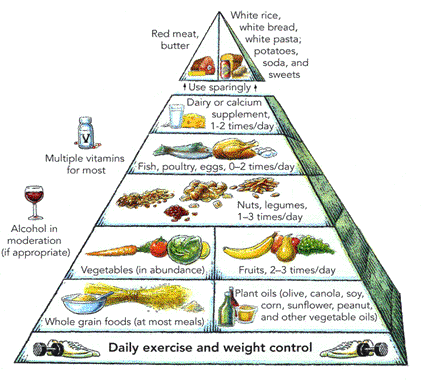
The Mediterranean Diet
Grains are carbohydrates, or starches, that our bodies change to sugar. Sugar acts as fuel for muscles and organs. Bread, cereal, pasta, rice, and other members of this group also supply minerals. Most members of the grain group contain very little fat. But not all carbohydrates are created equal. Whole-grain carbohydrates, such as bran and brown rice, have lots of vitamins, minerals, and fiber. Refined grains (that have not been enriched) have had their bran, germ, and oils removed and have fewer vitamins, minerals, and fiber. This makes whole wheat bread and brown rice better nutritional choices than unenriched white bread and white rice (think "good carb" and "bad carb")
Vegetables and fruits are complex carbohydrates that provide fiber and are packed with vitamins, minerals, and other important substances. Vitamin C, plentiful in many fruits and vegetables, may help reduce the risk of heart disease, cancer, strokes, and other diseases. Beta-carotene, which is found in yellow and orange vegetables such as carrots and yams, is another important substance.
Many nutrition experts suggest that you think of animal protein as a side dish to accompany vegetables and grains, rather than the other way around. In some societies, meat is actually used as a seasoning. Try including small amounts of chicken or beef in a vegetable stir-fry or in sauces for pasta dishes. You can easily get all the vegetable protein you need by combining proteins from several different vegetables in one meal. Dried beans, lentils, and lima beans are excellent sources of soluble fiber and protein. Nuts are another good protein source - snack on them or toss them on salads and vegetables - but remember they are high in fat.
Fats, oils, and sweets make up the tip of the pyramid. These items are usually added to foods during preparation or processing, so you may not need to use as much of them. One option for people with high cholesterols is to take either Benecol or Promise Activ margarines; using these in the doses recommended on the label may lower cholesterol by 10 to 30 points.
A couple of simple rules:
- Eat the rainbow: try to eat all the colors of the rainbow - orange, green, purple, red, yellow
- If it is wrapped in plastic, you should probably limit you patronage!
- If you want to lose weight, cut your portions by 1/3, and push away from the table when you are still a little hungry
- Exercise helps you maintain your weight, but do NOT expect it to magically make you lose weight
The above general diet applies to those with diabetes as well. A few additional suggestions for diabetics:
- Use a sugar substitute (like Splenda [sucralose], Equal [aspartame], Sweet & Low [saccharin])
- Avoid regular soda. I suggest drinking water or one of the fruit-flavored 0 calorie waters. Diet soda is another alternative, though I am not in favor of consuming large amounts of sugar subsitutes.
- Be careful about buying "low fat" snacks, as they often have quite a bit of sugar in them
- Limit carbs in favor of higher protein foods (nuts, fish, vege-meats, beans [like red beans, black beans, chick peas, lentils, etc], as well as favoring fruits and vegetables (which do have carbs) over the more traditional grain-based carbs (like pasta, breads, crackers, muffins).
| Number of Servings | ||||
|---|---|---|---|---|
| Food Group | 1200 cal | 1600 cal | 2000 cal | 2500 cal |
| Bread, Cereal Pasta, Rice, Starchy Vegetables | 3 | 4 | 7 | 10 |
| Fruits | 3 | 3 | 3 | 5 |
| Vegetables | 4 | 4 | 4 | 4 |
| Meat, Poultry, Fish | 2 | 2 | 2 | 2 |
| Eggs, Whole | 4/week | 4/week | 4/week | 4/week |
| Milk, Cheese, Yogurt | 2 | 3 | 3 | 4 |
| Fats, Oils | 3 | 4 | 6 | 8 |
| Desserts, Sweets, Alcohol | 0 | 2 | 2 | 2 |
One serving from the grain group is (but make it whole grain):
|
One serving from the dairy group is:
|

